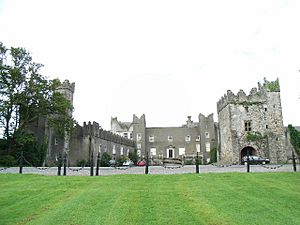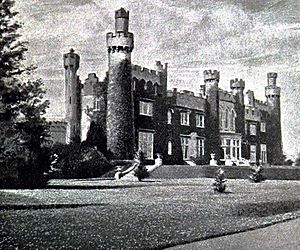Nicholas St Lawrence, 9th Baron Howth facts for kids
Nicholas St. Lawrence, 9th Baron Howth (born around 1550, died 1607), was an important Irish nobleman in the late 1500s and early 1600s. Even though he was openly Roman Catholic, he was trusted by Elizabeth I, the Queen of England, and by the English leaders in Ireland called Lord Deputies. He was even forgiven for signing a petition that asked for changes to the strict laws against Catholics, known as the Penal Laws.
Contents
Early Life and Family Troubles
Nicholas was the oldest son of Christopher, 8th Baron Howth, and his first wife, Elizabeth Plunket. He was likely born earlier than 1555, perhaps around 1550. People described him as being quite old by 1605.
His childhood was very difficult because his father was known for being cruel to his family. In 1577, Nicholas's teenage sister, Jane, died after being badly beaten by their father. His mother was treated so poorly that she left home because she feared for her life. Nicholas and his siblings lived in fear of their father. A special court, called the Court of Castle Chamber, which was like England's Star Chamber, allowed his mother to legally separate from his father. Lord Howth was fined for his cruelty and spent a short time in prison.
A famous story tells that Granuaile, a well-known pirate queen from Galway, arrived at Howth Castle for dinner around 1575. She found the castle gates closed. To get back at them for being rude, she took the young heir to the castle as a hostage. She held him until the family said sorry. Historians think this story might be partly true. If the heir was a child at the time, it was probably Nicholas's oldest son, Christopher, not Nicholas himself.
In the 1580s, Nicholas lived in Platten, County Meath, where his first wife, Margaret, owned land. He was made a knight in 1588. The next year, he became Baron Howth after his father passed away.
Political Role
Lord Howth was very dedicated to the interests of the Pale, which was the part of Ireland controlled by the English. Sometimes, this made it hard for him to agree with the English government's wishes. This became especially true when it was known that he was a Roman Catholic.
Early Relations with Government
At first, Nicholas got along well with the Lord Deputy of Ireland, Sir William FitzWilliam. He was even put in charge of the Pale when the Deputy was away. However, their relationship soon became strained. Nicholas got involved in a long and bitter argument between the Nugent and Dillon families. This argument was led by Christopher, Baron Delvin, and Sir Robert Dillon, a chief judge. The Nugent family accused Dillon of corruption for several years, but Dillon was cleared of all charges in 1593. Lord Howth was closely involved in these accusations.
It's not clear why Nicholas got involved. Lord Delvin said that Howth had been hurt by Lord Deputy FitzWilliam. But Howth himself said he trusted FitzWilliam. It's more likely that Nicholas was influenced by his second wife's father, Sir Nicholas White. White was another strong enemy of Dillon. This might explain why Howth lost favor with the Crown, as White's loyalty was questioned. White later died as a prisoner in the Tower of London.
Restored to Favor
Howth later regained the trust of the Crown. He had a good relationship with the new Lord Deputy, Lord Russell. Howth even hosted Lord Russell at Howth Castle when he first arrived in Ireland. The next year, Howth joined Russell on a military campaign against the O'Byrnes in County Wicklow. The Lord Deputy wrote that Howth deserved thanks from the Queen. In 1598, Howth was highly praised for being one of the few nobles from the Pale to help Sir Henry Bagenal in his fight against Hugh O'Neill. However, Howth later complained about Bagenal's soldiers causing damage in the Pale.
In 1600, he was again the first leader from the Pale to host a new Lord Deputy, Charles Blount, 8th Baron Mountjoy. Lord Mountjoy thought very highly of Howth and appointed him to act as Deputy when he was away. In 1601, Howth traveled to London to talk about Irish matters. The Queen had already met and liked Howth's oldest son, Christopher. She also formed a good opinion of Howth himself. When he returned, he was appointed to the Privy Council of Ireland, a group of important advisors.
Religious Beliefs
Howth's first wife, Margaret, was the daughter of Sir Christopher Barnewall. Sir Christopher seemed to follow the official Church of Ireland, but he secretly remained a Roman Catholic. Christopher's son, Patrick Barnewall, became a spokesperson for Catholic nobles in the early 1600s. Although Nicholas and Patrick, who were brothers-in-law, had argued over a lawsuit in the 1590s, they later became friends. Like Patrick, Howth openly said he was Catholic, as did Howth's son-in-law, Lord Gormanston.
In December 1605, Howth and Barnewall signed a petition asking for the Penal Laws to be changed, not made stricter. This was a risky thing to do, especially right after the discovery of the Gunpowder Plot in England. As a result, Barnewall was sent to the Tower of London, but Howth was left alone. He was trusted by another Deputy, Sir Arthur Chichester. It was said that Chichester and Howth would openly discuss the differences between their faiths. This friendship was surprising because Chichester was very against Catholics and strongly enforced the Penal Laws. Perhaps to prevent any action against Howth, Chichester wrote that Howth was old and probably would not live much longer. This prediction was correct: Howth died in May 1607 and was buried in Howth Abbey. He left his heir an estate with many debts.
Family Life
Nicholas St. Lawrence had children with two wives.
Children with Margaret Barnewall
With his first wife, Margaret (who died in 1576), daughter of Sir Christopher Barnewall, he had three children:
- Christopher St Lawrence, 10th Baron Howth
- Thomas, who served in the Spanish army in the Netherlands
- Mary, who married William Eustace of Castlemartin.
Children with Mary White
With his second wife, Mary White, daughter of Sir Nicholas White, he had six more children:
- Richard
- Almeric
- Edward
- Margaret (died 1637), who first married Jenico Preston, 5th Viscount Gormanston, and then Luke Plunkett, 1st Earl of Fingall
- Eleanor
- Alison, who married Thomas Luttrell of Luttrellstown.
Alison Luttrell
His daughter Alison St Lawrence married Thomas Luttrell of Luttrellstown Castle in 1616. Thomas was a member of the Irish Parliament for County Dublin from 1613 to 1615. He was the grandson of Sir Thomas Luttrell, who was a chief judge in Ireland. Alison and Thomas had a daughter named Mary, who married William FitzWilliam, 3rd Viscount FitzWilliam. They also had five other children, including John and Thomas.
Thomas Luttrell died in 1634. A copy of his will (a legal document about what happens to his property after he dies) still exists. He left Alison a house called the dower house at Diswellstown, along with many animals like cattle, sheep, and horses.



